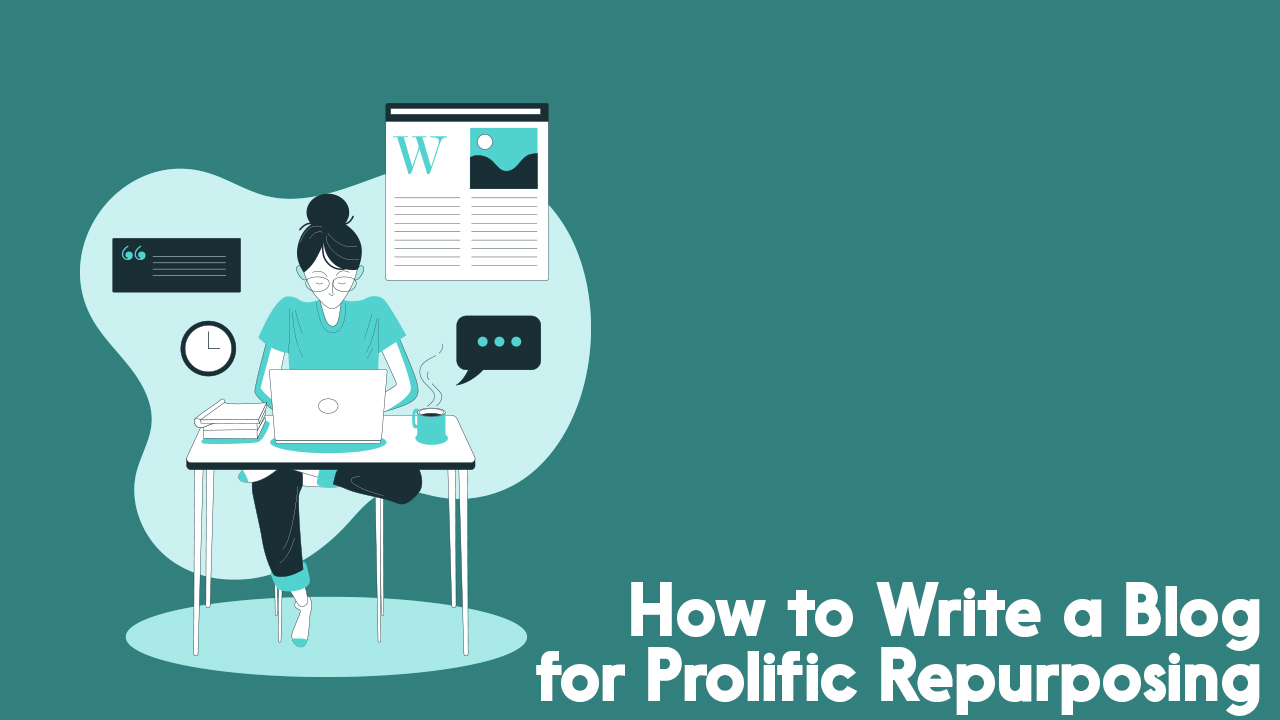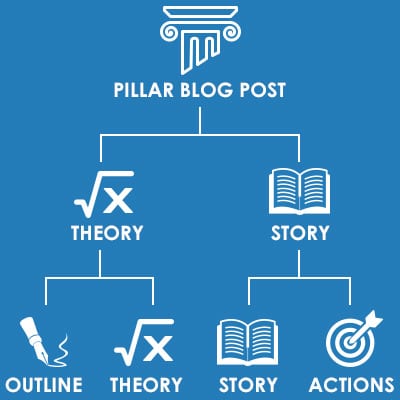How to Write a Blog for Prolific Repurposing

Now you know how content creation is going to work. If you’re following the 3-step process we covered in the previous chapter, it’s text first. Then media. Then back to text for the final few passes of editing. Simple, huh?

Content Stacking: How to Write a Blog
This is Chapter 6 of our Content Stacking series where we cover how to write a blog that can work alongside your podcast or video channel. Find the series introduction here.
If, though, you want to keep it more simple in the beginning, then you might be starting with media. You’ll record a video or a podcast, and then write the article based on that. That’s absolutely fine. If so, you might want to reverse the order of the next two chapters. Read Chapter 7 on media first, then come back here.
Or… you might be doing the 2-step process, but writing first, then recording. That’s fine then, stay right here. We’re about to talk writing.
How Does Text Work in Our Stack?
It’s time to get back to basics: text. How do we feature the written word in our stack? How do we write a blog for seamless and prolific repurposing?
You’ll remember from Chapter 1 that text, to us, is something like a net is to a fisherman. It’s how we capture the biggest part of our audience. After all, Google search is still the first stop for most when seeking out content.

The only difference is, the fisherman isn’t that interested in making fans of his fish. In fact, he’s more like the old school marketers: once you catch a fish, you club it over the head with your product. The old guard might daze a few fish into buying, but more often than not, they’re gonna kill off that potential fan.
Instead, we want to attract people with our hugely valuable, highly interesting written material, and then direct them on up the engagement stack by putting another article, a video or a podcast in front of them. That journey, from content piece to content piece, is what you’re fostering. It’s what turns a casual visitor, eventually, into a fanatical fan.
So… with that in mind, does it change how we use the written article?
Why Text is Always the Anchor
For every content idea, you always need at least one written article that covers it. Here’s why.

Discovery
We’ve covered this already: text is your net, your biggest source of search traffic. If you don’t have a written article, then you’re seriously reducing the possibility of people discovering your coverage of this content idea. That’s why we’re taking an in-depth look at how to write a blog in this chapter, after all.
Direction
Next, the written article provides direction to everything else you’ve created around this content idea. Sure, you can point people from the podcast to the video series, or one video to another, but text is a far lower barrier. In the article, you can cover the topic, and then provide a ‘hub’ that links to everything else you’ve produced on that subject.
Let’s say we’re talking ‘How to Replace a Tap.’ Your article gives the full low-down on this, offering step by step instructions on how to change that leaky water dispenser.
But, of course, you’ve recorded a video on the process too. That has turned it into 3 or 4 shorter clips, breaking it all down. Then you’ve repurposed that into a longer podcast episode.
So, the written article is the ‘hub’ that you always bring people back to, which then directs them to related media and resources.
Expansion
Before they head off to those other resources, though, your written article can offer expansion on what they’ve already consumed.
Say your audience member has happened upon the podcast first, or they’re a loyal subscriber, listening to the show every week. Audio is powerful and surprisingly effective at covering quite visual subjects. But, as the old saying goes, a picture is worth 1000 words…
So, direct people to the written article when they could benefit from a diagram, a graphic or an illustration.
Media moves at a set pace, but your audience can read in their own time. They can digest an image slowly, adding clarity to the audio or video narrative.
Now, while they’re there…
Monetisation
As I mentioned, the written article is a ‘hub’ for all the media you create around a concept. Well, this can include the resources you create which act as the incentive to jump into your funnel. Or, it can include products from the funnel themselves.
Over time, as you discover which content ideas hit home, you can develop checklists, flowcharts, ‘how to’ videos, infographics or even short courses on the topic. These are either tools to encourage email signups, or can be sold as paid products.
No matter what media you use, it’s the written article that’ll be home to these resources. Listeners can’t download directly from a podcast or signup directly from a YouTube video. You always need to direct them to a landing page. And, often, the written article is the central part of this.
Arguably, a dedicated landing page can be more effective, but I often like to use my written articles as that landing page. You can include resources and extras within that article, or perhaps at the top if you want to be very direct with the lead magnet.
Including it alongside the useful information is a great trust-builder, and you can have dedicated landing pages leading from that article if you prefer a harder sell.
Whatever approach you take, it’s the written article that’ll deliver leads and monetisation related to the media you create.

Revision
Finally, long after your audience consumes the content for the first time, they may want to revisit the ideas you covered. That pesky tap might break again, drip, drip, dripping through the night. At that point, they don’t need the whole podcast, or the whole video series again. They might just need a reminder of exactly how they remove the tap. That’s where text comes in again.
The written article is a quick resource which they can always come back to, review the material, skimming through to find that one step they’ve forgotten. Offering that chance to revise brings them back, again and again. Each visit, there’s a bigger and bigger chance they’ll convert on your product.
Is it Show Notes or a Blog Post?
Do I need to know how to write a blog if I just write show notes? This is a struggle for some that tend to treat their podcast or video series as the core of their content.
Show notes are the text accompaniment to a piece of media. Rarely will media stand on its own, after all. Even YouTube, a video-only platform, places a text title and description alongside every video they publish.
What Defines Show Notes?
The purpose of show notes is two-fold.
For those that haven’t yet consumed the media, they introduce the topic, describe the content and generally let the viewer or listener know what to expect.
For those that have listened or watched already, show notes are revision. We covered this just a moment ago. This is where consumers might review the material, and link out to the books, the products or the people that were mentioned.
What Should Shownotes Include?
First, show notes should sell the media. What’s included, what problems are being solved, and why should the reader listen?
Sounds like an outline or an introduction to me. Remember we covered that in the content structure chapter?
Next, show notes should cover the topic, allowing a listener or a viewer to revise it. There are plenty of episodes on numerous shows where I’ve come back, months later, and revisited the material.
Maybe I hit a point where the material was really relevant, or maybe I want to try or test something again. Either way, I need the material in an easy-to-skim format, something that’ll jog my memory from the first listen.
That sounds like the theory now.
I’ll want to refer to a story or two in my show notes, most likely the ones mentioned within the media. These give examples and context to the theory that we’ve covered.
Ok, that’s the case study section.
Finally, it should give some calls to action. These could and should include things like tasks, further reading/viewing and activities.
Sounds like the actions section…
So show notes, so far, sound like any other piece of content.
The Media Index: How to Write a Blog
The only element unique to show notes, for me, is the inclusion of an index.
The index will list the contents of an episode, showing time-codes for each particular section. That means if someone does want to revisit a particular point, or perhaps do a 1st listen, but only one particular part, they can jump right to it.
Here’s an example from the Tim Ferriss show and his interview with Erik Vance:
How did Erik Vance wind up living in Mexico City? [06:53]
How did Erik get interested in field biology? [07:42]
What was the turning point that transformed Erik from pure scientist to science journalist? [10:10]
Erik talks about his adventures with a porcupine, a recovering junkie, and a reformed devil worshiper in South Africa. [12:17]
Why nature documentaries usually require unnatural preparation. [18:04]
Erik talks about striking the balance between scientific precision and entertaining storytelling. [22:37]
We talk about story structure, the processes involved with writing a book, and tools for writers. [23:46]
Erik talks about one of his first, less-than-glamorous assignments as a new science writer (it involved swine manure and something called ladybug taint). [28:00]
Erik talks about growing up as a Christian Scientist — and not going to a doctor until he turned 18. [40:05]
Erik’s interest in the placebo effect comes from surviving a serious childhood disease. [44:50]
Erik talks about visiting NIH (National Institutes of Health) facilities so he could get repeatedly electrocuted — for science! [45:45]
The placebo effect isn’t always in your head — you may legitimately be experiencing measurable biochemical reactions. [49:06]
…. and it goes on …
You can even link to these time-codes within the media. YouTube, for example, allows you to link to particular time-points within a video, allowing viewers to get right to the part which is important to them.
Good Shownotes = Good Blog Post
It sounds, then, as if show notes are indistinguishable from a blog post, in terms of content. Done well, show notes should form a great blog post that stands on its own. They also direct readers to watch or listen to the related media as a follow-up.
That makes things simple. For every content idea, we’re creating at least one blog post. That serves as the main hub for the search engines on that content idea, and it acts as show notes for every piece of media that follows.
How to Write a Blog Post: Structure

Now, we have a few options. Think back to the structure chapter, and the ‘components’ required in the show notes that I described above. The default is that 4 part structure we’ve already discussed.
The first option is, then:
One Pillar Blog Post
Include all four sections in your blog post, and hit it out of the park. This is your one single hub on the web for this content idea.
You’ll include the podcast episode in a player at the top so that readers have an audio alternative. You’ll include a short video at the head of each section. We’ll go into that in much more detail in the next chapter. You’ll even have little media highlight clips, emphasizing the key points throughout.
This pillar blog post contains everything – the ultimate resource, in a true multimedia format, answering every question the reader has about that content idea.
Advantages: This approach exudes authority and a pillar article stands a good chance to get ranked in Google. It attracts links and shares, being seen as a traditional type of ‘ultimate guide’.
How to Write a Blog Using the Theory & Story Approach
An alternative is to separate out the theory and story elements of the content idea. In this approach, you end up with two blog posts related to the one content idea.
The first blog post introduces the topic, discusses the theory, and then proposes some actions. The second introduces the topic, covers 1 to 3 case studies or stories that show it being put into action, and then proposes some actions.
In each, the introduction is similar, and the actions are similar, but the actions include a pointer towards the accompanying blog post. If you’ve just read the story, then maybe you want to check out the theory, and vice versa.
Similarly, the theory might mention some elements of story, and link to that article. The stories might refer to some elements of theory, and link to that article.
Advantages: This approach starts to encourage further reading. Your bounce rate drops as people are encouraged to start clicking between related media. This can start to build trust early, as people cast a subtle vote of confidence, a silent ‘Yes!’, through that click. This can lead to further clicks, further trust and the start of the engagement ladder. Authority is still present, perhaps even more so when they start to see the web of engaging media spread out before them.
The Four (or More!) Part Approach
The final option is to go in-depth and create a blog post for each section of the structure. That means one introductory post, one theory post, one case study post and one actions, tasks, and further learning post.
That, of course, assumes you’re following my default ‘how to write a blog’ structure. You might have invented your own by now, in which case you could be creating 5, 6 or more posts related to your sections.
This takes more time and more mental effort, of course. You’re going deep, writing 400 or 500 words, just to introduce the topic. Next comes 1000+ words of theory, and the same to relate a few stories and case studies. Finally, you need to create a ’next steps’ post that puts it all into action, giving learning tasks, processes and further reading.
I have argued, though, that the content idea is the hard part. Writing is easy, once you have that plan in place. I often find what I think is a short subject, ballooning out into four or five 1000 word segments. So, if you can squeeze this out of each content idea, and then make that content idea just one part of a series, you can end up with EPIC streams of content that draws readers in, guiding them through, and turning engagement into trust at every step.
Advantages: The creation of epic streams of content. These resources are so in-depth and actionable that readers can’t help but succeed, ending up as huge advocates of your work and testimonials to its quality. Not to mention smaller lead-gen and engagement advantages. This includes offering the whole series as a PDF, guiding people through that ‘yes’ ladder with click after click, or much more purposefully directing them through the related media intended to showcase personality and grow trust.

Find Your Balance: How to Write a Blog Post
Remember the balance here. It’s possible to spend weeks… months even… delving into a content idea. There are authors who have made a career out of crafting one book about one detail of one aspect of one topic, after all. But, you have to find a balance between the depth you go into, and the time it takes to achieve. There are downsides to covering just one very specific topic over an extended period of time.
Niche is, more often than not, good. But, if you tie yourself down to just one very specific segment, you’re limiting your potential to be found online. Therefore, you want to cover a range of subjects within your topic.
That means you’re looking to find a level of depth that allows you to offer huge and unique value but still allows you to get a new topic out on a regular basis. The 2 part theory & story approach can be a good balance here. You’re delving in, but not so deep that it’ll take you a month to put the posts together.
Having said that, the depth, that extra mile, is often required if you really want to stand out. Perhaps it’s worth investing the time to write 5000 words over 5 or 6 different segments to create a set of posts on just one content idea. Again, that could then be just one part of a content series that covers the larger content concept.
I’ve said it before, I’ll say it again. Test it out.
How to Write a Blog Post for Prolific Repurposing: Your Tasks
- Try to create a Theory & Story pair of posts around the next content idea you have.
- Keep a track of the time, and reflect on the effort.
- Then, try crafting your following post idea into individual segments – Outline, Theory, Case Study, Actions.
- Post each segment as an individual blog article, linking from one to the next.
- Again, reflect on the time and effort, but place that against hard stats.
- Track how people navigate through the series, and ask for feedback from your audience.
- Is it encouraging more deep engagement, more action, more sharing and success?
Only through experiment and testing can we discover what works for us, and what works for our audience. Good luck!
Guide Index
- How Does Podcasting, Blogging & Video Work Together? #1
- Finding Content Ideas & Getting the Most From Every One #2
- A Podcast Structure for the Most Effective Teaching Possible #3
- Scripting & Presenting Content for Prolific Re-purposing #4
- The 3-Step Content Editing Process to Create Spectacular Clarity #5
- How to Write a Blog for Prolific Repurposing #6
- Recording Audio & Video for Prolific Repurposing #7
- Blog Posts that Grow Podcast Listeners & Video Viewers #8
- YouTube Videos that Drive Action & Promote Your Podcast #9
- How to Drive Action From a Podcast #10

